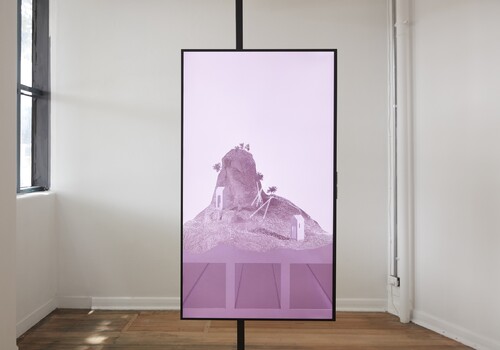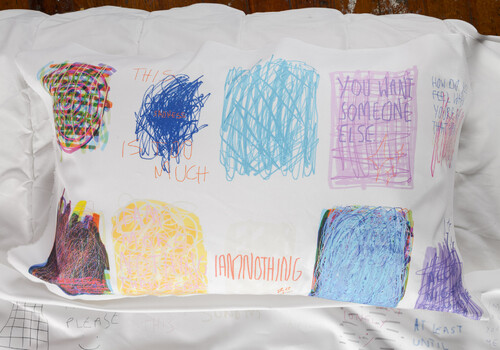Photography, Victorian College of the Arts
By Claire Osborn-Li
Home is a contested site in the work of several artists at this year’s VCA Photography Department. Home is a place of comfort: it is a hearty meal, soft sheets and warm hands. But, for some, home becomes fraught when it is the place of extreme isolation, or when it is a literal site of colonial contestation and settler sprawl.
The camera in Portrait, a video work by Celeste de Clario Davis, focuses on a pair of hands fumbling, itching, and cleaning. These are busy hands—even when they should be at rest, they tap with the clipped sound of nails or the soft thump of fingertips. Recovering from months of isolation, I’m comforted watching hands going about domestic chores, scrolling Instagram, or sewing quietly. This constant agitation should feel anxious, but somehow it feels calm, like home.

Isabella Imperatore’s photograph of a set table is also warmly domestic, revealing the aftermath of a meal. Empty wine glasses and plates have been licked clean. Recipes embroidered on silk napkins wrapped around plates remind us of what was eaten. Noticing the dimly lit space and the empty plates, I imagine heavy eyelids and full bellies, remembering my own sleepy satisfaction after enjoying a meal in good company. In Dutch still lifes the banquet is the treasured subject. Instead, 82 ‘A Tavula Mbandita cherishes a specific feeling: the contentment derived from a home-cooked meal eaten communally.
Home becomes portable in Anna McGirr’s Linen Sheet series. Each “linen sheet” is named with slight variations: (My Lover), (My Mother), (My own). Made from tufted wool and yarn, they recall the texture of carpet, soft between our toes. In combining personal relationships with soft materials associated with a domestic environment, these works each evoke a different locus of “home” that McGirr has found.

But comfort is challenged in another McGirr work, No God, No Body … Each word in the piece (“There Was No God/And There Was No Body”) is isolated, and the ambivalence of the phrase speaks of loneliness and disembodiment; she says “No Body”, but she also means “Nobody”. Materials that meant home are transformed into sites of isolation from others, as well as from the self.
The home is in more threatening territory in Jah Maskell’s works. Chair, which has nails lining the spine of its structure, is positioned in front of a TV playing Home, a video of someone shaving; but their face is cut and bleeding profusely. Notably, this is a bedroom: there is one chair, one TV, a mattress shed of its downy cushioning and a bed filled (of course) with nails.

While some questioned the space inside, the people nearby and the person within, Camille Perry took herself outside. Finding solace along walking trails, she began documenting the waste amassing in the area. This is Darebin Creek: vines droop over sewerage pipes and electronic ephemera piles up, made beautifully spooky in black and white photographs. Alongside them are Perry’s emotive handwritten letters to Darebin Council, infused with outrage at the colonial mindset that has led to production of waste en masse. Perry reminds us not only of the occupation of stolen land but also of the sheer mass of stuff that occupies and destroys it. Here seclusion is transformed into an opportunity for political action.
The events of this year have provoked a renewed fascination with domestic space for these artists, whose works confront the viewer with the question: Did you settle in? Or did you agitate against comfort? VCA’s Photography Department offers a sense of cosy belonging that remains precarious, threatening to collapse into hostile dislocation.
Claire Osborn-Li is an emerging art writer currently working on her undergraduate Honours thesis on tendencies of masochism in performance art and how they affect differing self/other paradigms at the University of Melbourne.




















